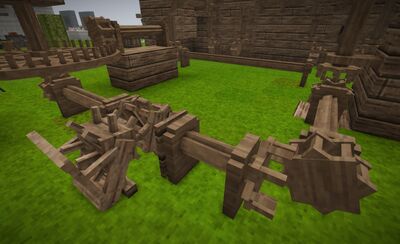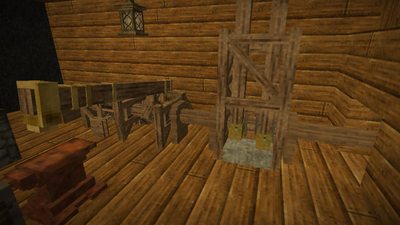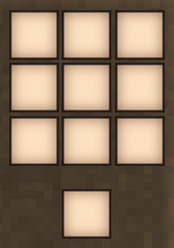Mechanical power: Difference between revisions
Mirotworez (talk | contribs) (Marked this version for translation) |
m (added category) |
||
| (6 intermediate revisions by 2 users not shown) | |||
| Line 3: | Line 3: | ||
<!--T:53--> | <!--T:53--> | ||
[[File:Powertrain.jpg|400px|right|thumb|Simple power train configuration.]] | [[File:Powertrain.jpg|400px|right|thumb|Simple power train configuration.]] | ||
'''''The mechanical work horse is the path to prosperity.''''' | '''''The mechanical work horse is the path to prosperity.''''' | ||
Mechanical power is a mechanic that allows for the powering of different machinery through the harnessing of renewable energy (such as wind) via structures such as the windmill. Currently, it can be used to automate querns for milling, helve hammers to work iron blooms or smith metal plates, and pulverizers to crush materials into their powdered form. | Mechanical power is a mechanic that allows for the powering of different machinery through the harnessing of renewable energy (such as wind) via structures such as the windmill. Currently, it can be used to automate querns for milling, helve hammers to work iron blooms or smith metal plates, and pulverizers to crush materials into their powdered form. | ||
Although it can be used to power a single machine, with a series of axle and gear connections, you can make what’s called a power train. This allows for the connection of multiple machinery at a time, working in tandem. | Although it can be used to power a single machine, with a series of axle and gear connections, you can make what’s called a power train. This allows for the connection of multiple machinery at a time, working in tandem. | ||
| Line 12: | Line 12: | ||
__TOC__ | __TOC__ | ||
==The Windmill== | ==The [[Windmill]]== <!--T:55--> | ||
A windmill is a multi-block structure used to harness wind power and transform it into mechanical power. There are many possible designs for a windmill but factors to consider include: | A windmill is a multi-block structure used to harness wind power and transform it into mechanical power. There are many possible designs for a windmill but factors to consider include: | ||
* Location windspeed | * Location windspeed | ||
| Line 20: | Line 20: | ||
Detailed information on the windmill can be found on the [[Windmill|windmill page.]] | Detailed information on the windmill can be found on the [[Windmill|windmill page.]] | ||
<!--T:91--> | |||
[[File:Example Power Train.png|400px|right|thumb|Example of working power train connecting to both a helve hammer and pulverizer.]] | [[File:Example Power Train.png|400px|right|thumb|Example of working power train connecting to both a helve hammer and pulverizer.]] | ||
==Power Train== | |||
==Power Train== <!--T:56--> | |||
A series of interconnected axles, gears, brakes and other mechanisms that allow for an uninterrupted flow of mechanical energy through multiple machines at the same time. | A series of interconnected axles, gears, brakes and other mechanisms that allow for an uninterrupted flow of mechanical energy through multiple machines at the same time. | ||
=== Materials required for a Powertrain === | === Materials required for a Powertrain === | ||
| Line 130: | Line 132: | ||
}} | }} | ||
==Automated Machinery== | ==Automated Machinery== <!--T:64--> | ||
===Milling=== | ===Milling=== | ||
Mechanized or not, querns enable the player to grind grain, as well as some minerals and stones into their processed forms. For mechanized milling, the quern must be attached to a functioning power train.<br> | |||
Querns can be automated further with the use of hoppers, chutes and chests. For the full automation guide, see the [[quern]] page. | |||
<!--T: | ===Smithing=== <!--T:70--> | ||
A helve hammer can help the player in processing iron blooms and blister steel, as well as making plates of any metal type. It requires mechanical power to operate and there is no practical way to automate the in- and output of materials, since it adheres to the same principles as manual smithing. | |||
For the full setup guide, check the [[helve hammer]] page. | |||
=== | === Crushing === <!--T:77--> | ||
''See also [[Pulverizer]].'' | |||
The pulverizer allows players to crush certain stones and minerals into fine powder to be used for [[Steel Making|steel making]] or [[Dye|dyes]]. There is no other way to obtain these materials. A full pulverizer setup requires a significant investment of boards and metal for the frame, toggle, pounders and caps. | |||
The pulverizer allows to crush certain stones and minerals into fine powder to be used for [[Steel Making|steel making]]. There is no other way to obtain these materials | |||
== Video Tutorials == <!--T:87--> | == Video Tutorials == <!--T:87--> | ||
| Line 327: | Line 165: | ||
|} | |} | ||
< | </translate> | ||
[[Category:Mechanisms]] | |||
{{tnt|Navbox|Vintage Story}} | |||
Revision as of 19:45, 26 June 2022
The mechanical work horse is the path to prosperity.
Mechanical power is a mechanic that allows for the powering of different machinery through the harnessing of renewable energy (such as wind) via structures such as the windmill. Currently, it can be used to automate querns for milling, helve hammers to work iron blooms or smith metal plates, and pulverizers to crush materials into their powdered form. Although it can be used to power a single machine, with a series of axle and gear connections, you can make what’s called a power train. This allows for the connection of multiple machinery at a time, working in tandem.
The Windmill
A windmill is a multi-block structure used to harness wind power and transform it into mechanical power. There are many possible designs for a windmill but factors to consider include:
- Location windspeed
- Height - for wind and clearance for sails
- Accommodation of various power train designs and equipment
- Amount of power needed to drive attached equipment
Detailed information on the windmill can be found on the windmill page.
Power Train
A series of interconnected axles, gears, brakes and other mechanisms that allow for an uninterrupted flow of mechanical energy through multiple machines at the same time.
Materials required for a Powertrain
Wooden Axles Used to transmit the wind power in a straight line. These may be placed vertically or horizontally in any of the cardinal directions.
| Ingredients | Crafting Recipe |
|---|---|
| Hammer Chisel log Fat |
Wooden Gears Allows the mechanical power to make a right angle turn by connecting a horizontal axle to a vertical one. Often needed depending on the design of the power train.
| Ingredients | Crafting Recipe |
|---|---|
| Hammer Saw Chisel Stick (2x) Log Resin Fat |
Brake Can be used to apply a lot of resistance to the mechanism in order to bring the entire train to a halt.
| Ingredients | Crafting Recipe |
|---|---|
| Hammer Chisel Log Wooden Axle Resin (2x) |
Clutch and Transmission
When placed together can be used to interrupt flow of energy to a specific branch of the powertrain.
| Ingredients | Crafting Recipe |
|---|---|
| Hammer Saw Chisel Boards (8x) Sticks (8x) Log Resin (2x) Fat |
| Ingredients | Crafting Recipe |
|---|---|
| Hammer Saw Chisel Boards (8x) Angled gears (2x) Resin (2x) Fat |
Input and output
Input and output is handled using chutes, hoppers and optionally chests. Hoppers accept multiple stacks of input items, which are then transported via chutes towards the input slot of an eligible block. A special type of chute, the Archimedes screw, can transport items upward provided it is powered.
Hopper (optional):
Used for material input/output. Crafted directly from copper plates.
| Ingredients | Crafting Recipe |
|---|---|
| Copper plate (3x) |
Chute (optional):
Used to direct materials from hoppers into chests or other containers (or the quern itself). These blocks can be placed directionally, with the output facing away from the player. Chutes are crafted from chute sections, which need to be crafted on an anvil with copper ingots, by hand or with the help of a helve hammer. As even the straight chute needs at least two sections, a minimum of two copper ingots is necessary for one chute.
Chest (optional):
Can be placed on top of a straight chute above the quern to direct materials into the quern input slot
| Ingredients | Crafting Recipe |
|---|---|
| Boards (8x) |
Automated Machinery
Milling
Mechanized or not, querns enable the player to grind grain, as well as some minerals and stones into their processed forms. For mechanized milling, the quern must be attached to a functioning power train.
Querns can be automated further with the use of hoppers, chutes and chests. For the full automation guide, see the quern page.
Smithing
A helve hammer can help the player in processing iron blooms and blister steel, as well as making plates of any metal type. It requires mechanical power to operate and there is no practical way to automate the in- and output of materials, since it adheres to the same principles as manual smithing. For the full setup guide, check the helve hammer page.
Crushing
See also Pulverizer.
The pulverizer allows players to crush certain stones and minerals into fine powder to be used for steel making or dyes. There is no other way to obtain these materials. A full pulverizer setup requires a significant investment of boards and metal for the frame, toggle, pounders and caps.
Video Tutorials
| Explanation of Big Gear usage | Generall Mechanical Explanation |
|---|---|
| How to build a windmill and Helve hammer in version 1.13 | How to build a pulverizer in version 1.14 | How to automate a pulverizer |
|---|---|---|
| {{{title}}} | |
|---|---|


